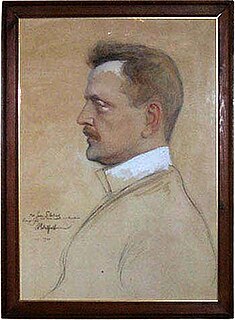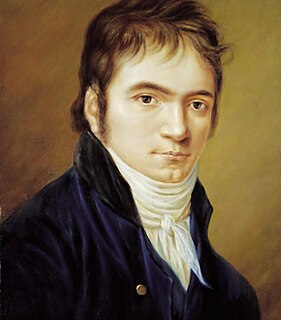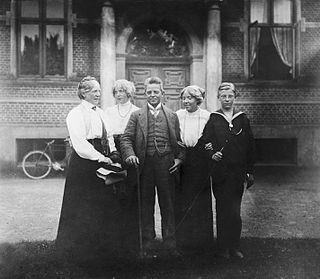Related Research Articles

A string quartet is a musical ensemble consisting of four string players – two violin players, a viola player and a cellist – or a musical composition written to be performed by such a group. The string quartet is one of the most prominent chamber ensembles in classical music; most major composers from the mid 18th century onwards having written string quartets.

Chamber music is a form of classical music that is composed for a small group of instruments—traditionally a group that could fit in a palace chamber or a large room. Most broadly, it includes any art music that is performed by a small number of performers, with one performer to a part. However, by convention, it usually does not include solo instrument performances.
The Piano Quintet in F minor, Op. 34, by Johannes Brahms was completed during the summer of 1864 and published in 1865. It was dedicated to Her Royal Highness Princess Anna of Hesse. Like most piano quintets composed after Robert Schumann's Piano Quintet (1842), it is written for piano and string quartet.
The Symphony No. 94 in G major is the second of the twelve London symphonies written by Joseph Haydn. It is popularly known as the Surprise Symphony.

The Violin Concerto in D minor, Op. 47, was written by Jean Sibelius in 1904, revised in 1905. It is his only concerto. It is symphonic in scope, with the solo violin and all sections of the orchestra being equal voices. An extended cadenza for the soloist takes on the role of the development section in the first movement.
The String Quartet No. 15 in G major, D. 887, was written by Franz Schubert in June 1826. It was posthumously published in 1851, as Opus 161.

The String Quartet No. 9 in C major, Op. 59, No. 3, was written by Ludwig van Beethoven and published in 1808. This work is the third of three of his "Razumovsky" cycle of string quartets, and is a product of his "middle" period. It consists of four movements:
The Symphony No. 1 in C minor, Op. 68, is a symphony written by Johannes Brahms. Brahms spent at least fourteen years completing this work, whose sketches date from 1854. Brahms himself declared that the symphony, from sketches to finishing touches, took 21 years, from 1855 to 1876. The premiere of this symphony, conducted by the composer's friend Felix Otto Dessoff, occurred on 4 November 1876, in Karlsruhe, then in the Grand Duchy of Baden. A typical performance lasts between 45 and 50 minutes.
String Quartet No. 1 is a musical composition by Charles Ives. Music historian and theorist Robert P. Morgan wrote that the quartet "was Ives's first mature composition of extended length, and its extraordinary fluency gives ample evidence of his solid control of traditional musical techniques. Moreover, the work is considerably more than a facile exercise based on classical models; there are already indications of the Ives to come, in the extensive quotations and, above all, in the composer's ability to bend the form to suit the idiosyncrasies of his own musical inclinations."
The Unanswered Question is a musical work by American composer Charles Ives. Originally paired with Central Park in the Dark as Two Contemplations in 1908, The Unanswered Question was revised by Ives in 1930–1935. As with many of Ives' works, it was largely unknown until much later in his life, and was not performed until 1946.
The Piano Trio No. 2 in E minor, for violin, cello and piano, Op. 67, by Dmitri Shostakovich was written in 1944, during World War II.

Charles Ives's Symphony No. 4, S. 4 was written between 1910 and the mid-1920s. The symphony is notable for its multilayered complexity—typically requiring two conductors in performance—and for its large and varied orchestration. Combining elements and techniques of Ives's previous compositional work, this has been called "one of his most definitive works"; Ives' biographer, Jan Swafford, has called it "Ives's climactic masterpiece".
The six String Quartets, Op. 76 by Joseph Haydn were composed in 1797 or 1798 and dedicated to the Hungarian count Joseph Georg von Erdődy (1754–1824). They form the last complete set of string quartets that Haydn composed. At the time of the commission, Haydn was employed at the court of Prince Nicolaus Esterházy II and was composing the oratorio The Creation as well as Princess Maria Hermenegild Esterházy's annual mass.

The six string quartets opus 20 by Joseph Haydn are among the works that earned Haydn the sobriquet "the father of the string quartet". The quartets are considered a milestone in the history of composition; in them, Haydn develops compositional techniques that were to define the medium for the next 200 years.

The Piano Quartet No. 1 in G minor, Op. 25, was composed by Johannes Brahms between 1856 and 1861. It was premiered in 1861 in Hamburg, with Clara Schumann at the piano. It was also played in Vienna on 16 November 1862, with Brahms himself at the piano supported by members of the Hellmesberger Quartet. Like most piano quartets, it is scored for piano, violin, viola and cello.
The Second String Quartet by American composer Elliott Carter was completed in 1959. This composition for string quartet was commissioned by the Stanley String Quartet of the University of Michigan, who decided not to play it upon seeing the score, and received its first performance in 1960 by the Juilliard String Quartet.
The Fourth String Quartet by American composer Elliott Carter was composed in 1985–86 in New York City and Rome, and completed in June 1986. It was premiered on September 17, 1986 at Festival Miami, University of Miami, Florida by the Composers String Quartet.
American composer Elliott Carter's String Quartet No. 5 is a composition for string quartet. The work was composed between January and July 1995, as a commission for the Arditti Quartet by the city of Antwerp, by the Wittener Tage für neue Kammermusik, by the Festival d'Automne à Paris, and by Lincoln Center, New York. It was premiered by the Arditti Quartet in Antwerp at deSingel International Art Centre on September 19, 1995.
String Quintet No. 2 in G major, Op. 111, is a work by Johannes Brahms composed in 1890 and published in 1891. It is known as the Prater Quintet. Brahms intended it to be his last piece of music, though he later produced a number of piano pieces and the two sonatas for clarinet or viola and piano. The first performance of the Quintet in Vienna on November 11, 1890 was a sensation.

Carl Nielsen's String Quartet No. 4 in F major or Quartet for Two Violins, Viola and Cello in F major, Opus 44, was composed between February and July 1906. The last of Nielsen's four string quartets in the official series, its first public performance took place on 30 November 1907 in Copenhagen.
References
- ↑ "CHARLES IVES – String Quartet No. 2 – String Quartets – A Most Intimate Medium" . Retrieved 2019-04-18.
- 1 2 Sinclair, James B. (1999). A Descriptive Catalogue of the Music of Charles Ives. Yale University Press. p. 171.
- ↑ Burkholder, J. Peter, ed. (1996). Charles Ives and his World. Princeton University Press. p. 345.
- ↑ Ives, Charles (1972). Kirkpatrick, John (ed.). Charles E. Ives: Memos. W. W. Norton. p. 73.
- ↑ Sinclair, James B. (1999). A Descriptive Catalogue of the Music of Charles Ives. Yale University Press. p. 170.
- ↑ "Charles Ives: String Quartet No. 2: Ives Society Critical Edition by Malcolm Goldstein". Peermusic Classical. Retrieved November 9, 2020.
- ↑ "String Quartet No. 2, for string… | Details". AllMusic. Retrieved 2019-04-18.
- ↑ McDonald, Matthew (2014). Breaking Time's Arrow: Experiment and Expression in the Music of Charles Ives. Indiana University Press. p. 57.
- ↑ McDonald, Matthew (2014). Breaking Time's Arrow: Experiment and Expression in the Music of Charles Ives. Indiana University Press. p. 58.
- 1 2 3 4 5 6 Morgan, Robert P. (1975). Charles Ives: String Quartets Nos. 1 & 2 (liner notes). The Concord String Quartet. Nonesuch Records. H-71306.
- ↑ Swafford, Jan (1996). Charles Ives: A Life with Music. W. W. Norton. p. 239.
- ↑ Ives, Charles (1954). Quartet No. 2. Peer International Corporation. p. 12.
- ↑ Ives, Charles (1954). Quartet No. 2. Peer International Corporation. pp. 12–13.
- ↑ McDonald, Matthew (2014). Breaking Time's Arrow: Experiment and Expression in the Music of Charles Ives. Indiana University Press. p. 62.
- ↑ Ives, Charles (1954). Quartet No. 2. Peer International Corporation. p. 13.
- ↑ Ives, Charles (1954). Quartet No. 2. Peer International Corporation. p. 15.
- ↑ Ives, Charles (1954). Quartet No. 2. Peer International Corporation. p. 16.
- ↑ Ives, Charles (1954). Quartet No. 2. Peer International Corporation. p. 18.
- ↑ McDonald, Matthew (2014). Breaking Time's Arrow: Experiment and Expression in the Music of Charles Ives. Indiana University Press. p. 64.
- 1 2 McDonald, Matthew (2014). Breaking Time's Arrow: Experiment and Expression in the Music of Charles Ives. Indiana University Press. p. 65.
- ↑ Swafford, Jan (1996). Charles Ives: A Life with Music. W. W. Norton. p. 240.
- ↑ Schmidt, Dörte (2012). "'I try to write music that will appeal to an intelligent listener's ear.' On Elliott Carter's string quartets". In Boland, Marguerite; Link, John (eds.). Elliott Carter Studies. Cambridge University Press. pp. 174–175.
- ↑ Paul, David C. (2013). Charles Ives in the Mirror. University of Illinois Press. p. 74.
- ↑ Moevs, Robert (January 1975). "Review: Elliott Carter: String Quartets Nos. 2 and 3 by The Juilliard Quartet". The Musical Quarterly. 61 (1): 164–165.
- 1 2 3 Moevs, Robert (January 1975). "Review: Elliott Carter: String Quartets Nos. 2 and 3 by The Juilliard Quartet". The Musical Quarterly. 61 (1): 165.
- ↑ Hurwitz, Robert (1974). Elliott Carter: String Quartet Nos. 2 and 3 (liner notes). Juilliard String Quartet. Columbia Records. MQ32738.
- ↑ Ferneyhough, Brian (1995). "String Quartet No. 4". In Boros, James; Toop, Richard (eds.). Collected Writings. Harwood Academic Publishers. p. 160.
- ↑ Fitch, Lois (2013). Brian Ferneyhough. Intellect Books. p. 188.
- ↑ Archbold, Paul (May 16, 2011). "Performing Complexity". Scribd. p. 23. Retrieved November 9, 2020.